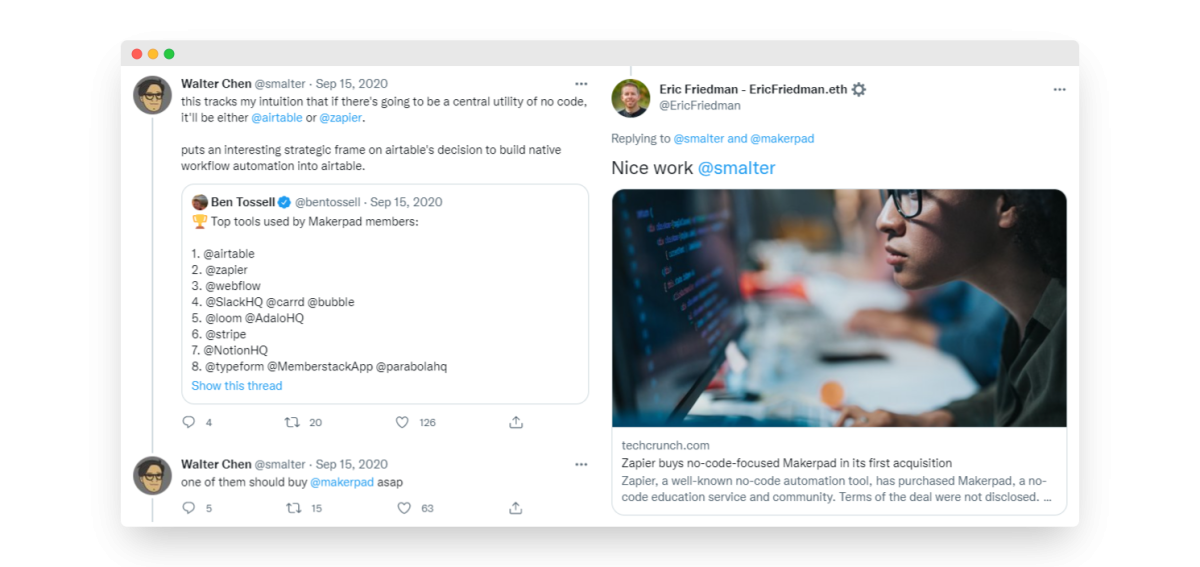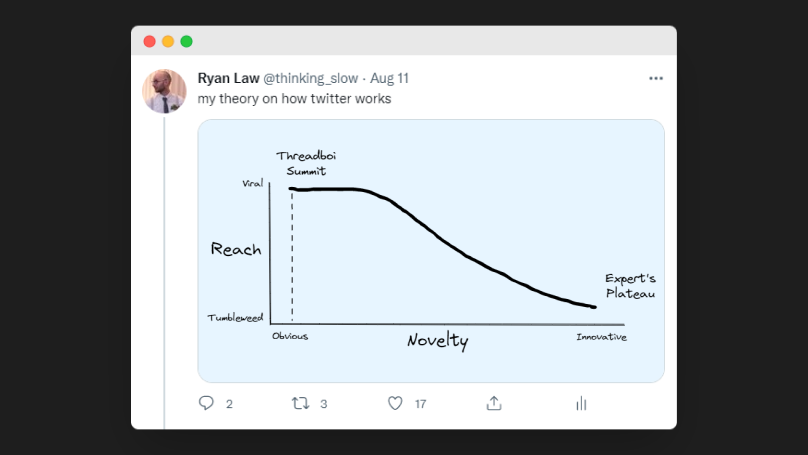Twitter is pretty consistently the fourth-best traffic source for Animalz. And that’s great—but it’s also entirely the wrong way to think about social media. Here’s a better way to frame the power of social media, a story told in three short tweets:

We’re grateful for the thousands of website visits Twitter brings, but we care much more about the hundreds of thousands of impressions our social content gets, the co-marketing opportunities, webinar and podcast invitations, personal connections, and new business it generates. (And the company acquisitions it precipitates).
The story of social media is told outside of your website analytics and pageview data.
Twitter provides a way to bring decision-makers into your own social graph. It’s a place where, with a little thought, your ideas and beliefs can spread without a huge audience. It’s an opportunity to be invited into a space where real people spend real time, a chance to blur the boundary between personal and professional.
It’s a place where you really can “thought lead”: sharing your ideas and beliefs in a way that influences the way real people think — and buy.
Social Simulacra: What Most Companies Get Wrong About Twitter
Problem is, most companies view social media as either an obligation — somewhere they have to be present in some form — or as a way to funnel clicks through to a blog post or landing page.
Here’s a representative tweet from Amazon UK — 1.5 million followers and… 11 likes:
Let predictive text complete your sentence 📲 “My back-to-school purchase will be ___” What did you get? 👀 — Amazon.co.uk (@AmazonUK)
These types of results are not unusual for many companies’ Twitter efforts. Perhaps they don’t care about ROI, or more likely, ROI is too complicated and opaque for anyone to ever be held to account. This has a trickle-down effect: it’s easy to assume that is what B2B social media is meant to look like.
But these problems aren’t inevitable. They’re the natural consequence of how these brands use Twitter:
They broadcast and never engage. Many companies view social media as a broadcast platform, a place for pumping content created for other spaces — like search-optimized articles and press releases — into social feeds. And surprise, surprise: no one cares.
They try to lure readers back to their website. Companies use social media as a place to dump blog post links and cajole the reader into clicking out of the network and back to their website. But, as we’ve written before, the reader “would be happier to get the value right here, on their terms, in whatever space they’ve chosen.”
They shill their own brand. Most branded Twitter accounts look like the pool of Narcissus, swarming as they are with product updates, press releases, and endless reflections of the company logo.
They publish stuff that looks like Social Media Content™. In the same way that most blog posts have the distinctive reek of “content marketing” about them, most social content — with its #BrandedHashtags and bit.ly links — feels like a marketing ploy.
It doesn’t have to look like this.
How We Approach Twitter Content
We create Twitter content for ourselves and our customers. Here are some of the principles that guide our hand:
1. Build Equity in Your Personal Brand
You’ve heard the adage “people buy from people.” The Twitter equivalent is “people follow people.”
It’s easier for followers to trust the advice and intentions of a real person than of a branded company account. It’s also easier to create content for yourself than it is for a company — you can tap into your own experiences, opinions, and ideas.
This type of content performs well. People like it when you tell the story of your personal experiences, wherever you think they’ll prove helpful to other people:
I’m fired up to share that Heyday raised a $6.5M Seed led by @kevinthau @SparkCapital We’re sharing our pitch deck as a resource for founders trying to raise in this environment 👇 — Sam DeBrule (@SamDeBrule)
Or when you share the mistakes you made, and how other people can avoid the same fate:
A couple years ago, we spent $2 million on an ad campaign for Wistia. We went big: web ads, NPR, billboards. It was one of the most expensive mistakes we’ve ever made. — Chris Savage (@csavage)
Or when you use your experience to provide context for the events happening in the world around you:
Trying to order groceries online and wondering why you can’t get a delivery slot? The answer is that online grocery delivery wasn’t designed for ecommerce. A thread 👇 — Pradeep Elankumaran (@pradeep24)
There’s a serendipitous benefit to personal branding. You can impart a halo effect on your company by shining a light on the company operations by retweeting branded content (and adding your own layer of context) and reminding your followers that there are real, breathing people on the other side of that company name and logo.
This is not to say that you should abandon your brand accounts: just that personal brands are often a simpler, more accessible (and more fun) starting point.
2. Distribute Ideas, Not Blog Posts
Many of the mistakes companies make stem from the ethos that Twitter — and all social media channels — functions only as a distribution channel for blog content. Unless we can get someone to click a link and come back to our website, logging a pageview in the process, the effort is worthless.
But the ultimate goal of marketing is trust-building, persuasion, and helping people to hear, understand and believe in our ideas — so what does it matter whether that idea is contained in a blog post or a tweetstorm?
Effective social requires you to create platform-native content: content that is tailored completely to the channel it is shared on. So instead of sharing links to blog posts or presentations, summarize the core takeaways right there in your social post, like this tweetstorm:
Most blog posts suffer from the same problem: they feel like content marketing It isn’t enough to solve a hard problem, or teach the reader something useful: you have to do it in a way that doesn’t patronise, mislead, or make them feel like the target of a marketing campaign 👇 — Ryan Law (@thinking_slow)
And, sometimes, be willing to experiment with content created solely for social media. Take this example: there is no corresponding blog post, no attempt at “repurposing.” This is a twitter-exclusive piece of content:
i started in content marketing 11 years ago. a lot has changed in that time back then, you could excel with simple keyword research skills and the ability to write quickly but not today. if i was starting my career over, here are 12 things i would do to land my first job: — Ryan Law (@thinking_slow)
3. Play to the Algorithm (Sometimes)
One observation about Twitter: dumb roundups of “free tools” and “Google Docs tips” usually perform better than smart, nuanced ideas. Or put another way:

This makes sense: “going viral” requires a tweet to have far-reaching appeal, and tweetstorms about books to read or free tools to use generally have a near-universal audience. The algorithm rewards these tweets… and while many people think this lessens the experience of using Twitter, we can use them to our advantage.
To draw a parallel to SEO strategy, “dumb” listicles and roundups can often provide the backlinks needed to improve the performance of so-called “money pages.” In the same way, great Twitter accounts leverage “dumb” tweetstorms to improve the performance of better content:
Smart, nuanced ideas to build trust with your target audience
Engagement bait to help amplify those ideas.
Twitter makes it particularly easy to identify top-performing topics, trends, and content types. Just pick an influencer of choice, use one of Twitter’s handy advanced search operators, and you can tap straight into a playbook of proven tweets.
Here are some of Wes Kao’s greatest Twitter hits:
These hooks and structures can be adapted to your own ends. But remember: these tweets are a means and not an end. The dopamine hit of virality is addictive, but at the end of the day, those tweets probably aren’t winning the hearts and minds of the people who would actually buy your product or service.
4. Use Social Dynamics to Incentivize Engagement and Amplification
In the idea-distribution-stakes, social networks have an innate advantage over blogging: they are networks, incentivizing and rewarding peer-to-peer connections. In other words, Twitter provides you with a toolkit for amplifying your reach simply by mentioning other users right there in your content.
Mentions and quote-retweets create powerful social incentives. The person creating the tweet benefits from the implicit association with the people they tag; as the tweet gains traction, the people featured have incentive to keep the snowball rolling.
This post from thread-master Sam DeBrule contains flattering shoutouts for 25 — literally twenty-five — different brands and people, each with their own social audiences and, now, incentives to share Sam’s tweet with those audiences:
Ruben Harris started Career Karma, a platform that helps people break into the tech industry, in 2018. Career Karma raised a $10 million Series A led by Garry Tan @initialized in 2020. This is a story of an outsider breaking into the Valley with sheer determination and hustle👇 pic.twitter.com/W90aDaWksY — Sam DeBrule (@SamDeBrule)
This tweet from Animalz founder Walter Chen does the same, mentioning the first YC cohort — a group of tech-conscious people who are likely to have active Twitter accounts and solid followings — by name.
yc’s first ever batch, summer ’05 where are they now? 👇 pic.twitter.com/ojK6TcPdv5 — Walter Chen (@smalter)
These mentions don’t feel sycophantic or out of place: Sam and Walter have chosen to tell the type of story that needs to reference these people. This is platform-native content at its finest, using the tools Twitter provides to their fullest potential.
When Companies Forget the “Social” Part of Social Media
Twitter is a social media network. Most companies have indexed heavily on the “media” portion of that descriptor at the expense of the “social” and “network” parts. They pump out content in prodigious quantities and forget that Twitter users care more about personal connections and enjoying themselves within the app than they do about branded content and blog posts.
Twitter is a great channel for B2B companies — you just need to ignore how other B2B companies use it. Focus on your personal brand, share helpful content within the platform, and use the tools Twitter provides — social dynamics and engagement bait — to amplify your growth.
